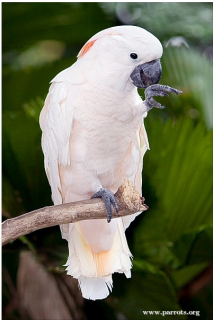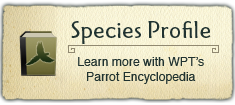Project Regions:
Moluccan Cockatoo |
|
|
Collaborators/Funders
Project Bird Watch
Indonesian cockatoo at risk from unsustainable trapping
The Moluccan Cockatoo (Cacatua moluccensis) is Vulnerable in the wild, owing to unsustainable harvesting and habitat loss.
Project progress: From 1990-2004 The World Parrot Trust supported the unique work of Project Bird Watch, which encourages the protection of key Moluccan Cockatoo habitat by sustainably harvesting Molucca nuts. Funds were also provided in 1995 for an expedition to Seram, and in 2001 to the nut project for processing equipment.
Outcomes: The Moluccan Cockatoo was placed on Appendix I and II of CITES by 1989, a measure which has reduced trade at the international level. Recently an awareness and education program was launched. Further work has determined that detailed research into the species' population dynamics, local movements and threats is needed. Wildlife trade monitoring and control is required through effective enforcement of legislation. Manusela National Park boundaries have apparently overlapped with logging concessions and this needs to be addressed. Creating a strict nature reserve in the Wae Fufa valley of north-east Seram has been determined to be a priority.
Wild population: As few as 10,000
Where found: Manusela National Park, Seram, and Hitu Peninusula, Ambon, Indonesia.
History: The Moluccan Cockatoo (Cacatua moluccensis) is listed as Vulnerable in the wild, according to IUCN. This species is found on Seram, Ambon, and historically Saparua and Haruku in South Maluku, Indonesia. It has not been seen recently on Saparua and Haruku, and it may only survive at one area on Ambon, leaving almost the entire population on Seram. It was once common there but has suffered significant declines, remaining only in Manusela National Park and E Seram. Population numbers have been little researched, and ones that have been done report widely different results. (BirdLife International, various authors) By the 1980s these birds were being unsustainably trapped for the wild bird trade, with an estimated 74,509 individuals having been traded between 1981 and 1990, on top of other human interference. The total population has been reported to be as low as 9640 birds in 2007 (Y.E. Persulessy in litt. 2007). Although international trade had fallen to zero by the 1990s there are still some 4000 birds traded domestically each year. (BirdLife International)
Threats:
- Ongoing and heavy trapping for domestic trade
- Loss of habitat due to logging, hydroelectric projects, human settlement
- Habitat fragmentation
Ecology: Moluccan Cockatoos favour forest and tall secondary growth in its native Manusela National Park. They are seen in pairs and small groups and are wary, but otherwise noisy and conspicuous. They are active early morning and late afternoon, keeping occupied through the day foraging for nuts, young coconut, seeds, berries and insects and their larvae.


































